Deal Comparison Scatter Plot
Overview
The Deal Comparison Scatter Plot Analytic is a graph that displays data points as a comparison set in a scatter plot chart. Oracle CPQ provides a user interface that allows administrators to define analytics by selecting from business-friendly options. Deal Comparison Scatter Plot Analytics can be defined to display the historical relationship between any two numeric Commerce attributes (currency, float, or integer). Once defined, Deal Comparison Analytics can be displayed in Commerce Transaction and Transaction Line UIs by associating the analytic with an HTML Commerce attribute. Deal Comparison Analytics can then be exposed to users by adding this HTML attribute to desktop and mobile UIs just like any other commerce attribute. Oracle CPQ 21D allows administrators to define data point cache settings for the HTML attributes. With this enhancement, the list of data points for the HTML attribute are cached and can be retrieved more efficiently.
For Transaction Deal Comparison Scatter Plots, each historical Transaction is shown as a data point. The following image shows a scatter plot of Total Discount Percentage as a function of Total List Revenue. All Transactions last modified within a specified time range are queried to acquire the historical data points displayed. A commerce Transaction won/lost status is used to determine won and lost deals. A curved blue line represents the best fit historical relationship of the variables shown on the X and Y axes. Hash lines indicate the Total Discount Percentage and Total List Revenue values for the current Transaction.
Oracle CPQ 20B enhances the value of the Deal Comparison Scatter Plot by enabling users to more easily compare and analyze related Transactions during their quoting process. In 20B, JET UI users can select a data point from a scatter plot analytic to open the Transaction or Transaction Line details in a new tab. End users are only able to access the Transaction or Transaction Line details that they have permission to view.
This example Deal Comparison Scatter Plot Analytic depicts a relationship of increasing willingness to buy by the customer when the Transaction discount is increased, and shows the exact position of the current deal pricing relative to this historical pattern.
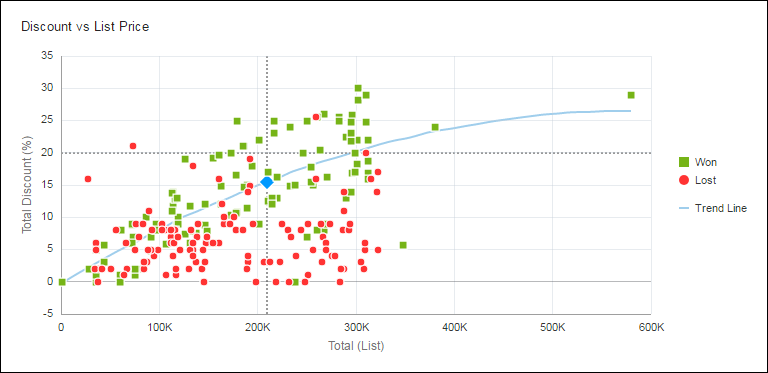
 Average Historical Value Hover
Average Historical Value Hover
When a customer hovers over a scatter plot data point, information for each historical Transaction is provided. The blue data point represents the Average Historical Value for Total Discount Percentage for Transactions with the same Total List Revenue value as the current Transaction.
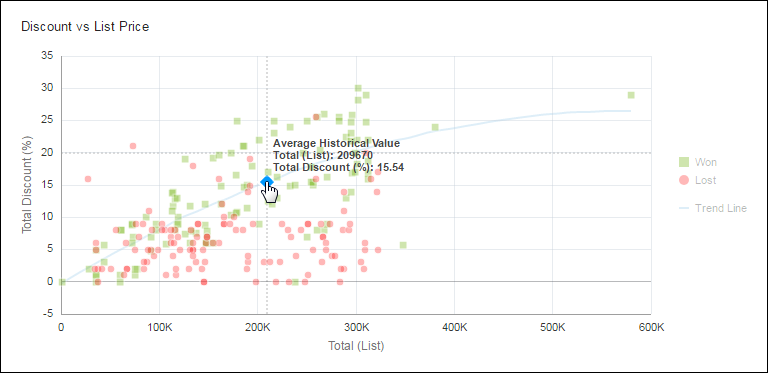
 "Won" Historical Value Hover
"Won" Historical Value Hover
When a customer hovers over a "Won" scatter plot data point, Total List Price and Total Discount Percentage are shown. In the following image the green data points represent won deals.
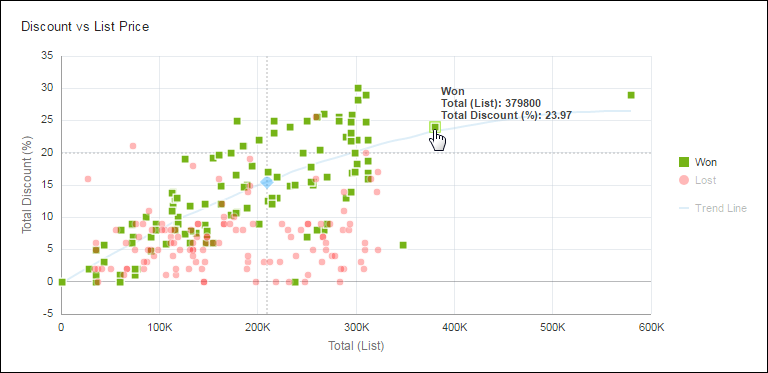
 "Lost" Historical Value Hover
"Lost" Historical Value Hover
When a customer hovers over a "Lost" scatter plot data point, Total List Price and Total Discount Percentage are shown. In the following image the red data points represent lost deals.
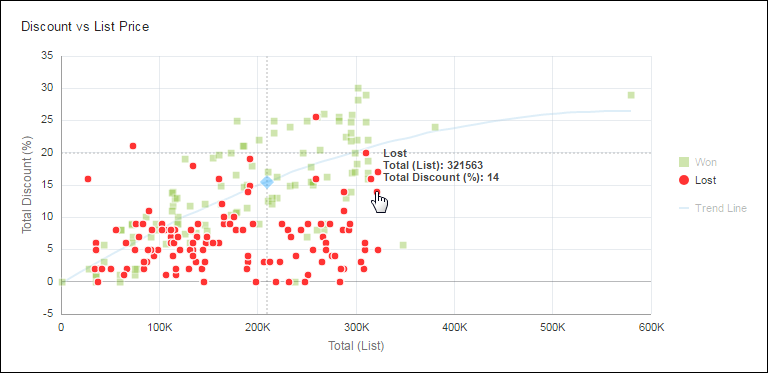
 "Current Deal" Hover
"Current Deal" Hover
When a customer hovers over the data point, or on the legend for the Current Deal, information for the current deal is displayed. The Current Deal information is displayed as a circular purple symbol. Sales users can better visualize the relationship of the current deal to historical deals and the historical trend line.
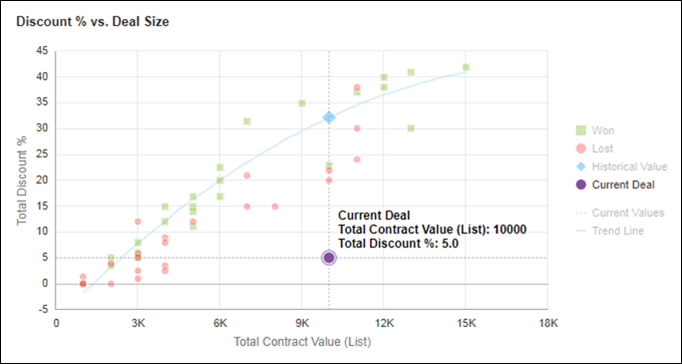
Administration
 Create a Scatter Plot Analytic
Create a Scatter Plot Analytic
 Navigate to the Process Administration page.
Navigate to the Process Administration page.
- Click Admin to go to the Admin Home Page.
-
Click Process Definition in the Commerce and Documents section.
The Processes page opens.
-
Click the Process link in the Name column.
The Process Administration page opens.
-
Select Analytics from the Navigation drop-down menu, then click List.
The Analytics List page opens.
-
Click Create Analytic.
The Analytic wizard opens.
-
Scroll through the filmstrip to the Scatter Plot option, then click Create.

The Analytics Definition Editor page opens.
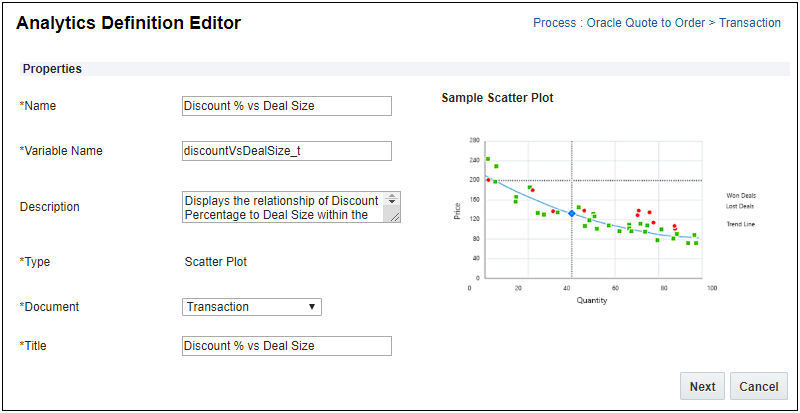
-
Define the following parameters:
- Name - The name for the analytic.
- Variable Name - The variable name for the analytic.
- Description (optional) - The description for the analytic.
- Document - The selected Commerce main document or sub-document. (i.e. Transaction or Transaction Line).
- Title - The title for the chart.
-
Click Next.
-
Define Chart Settings.
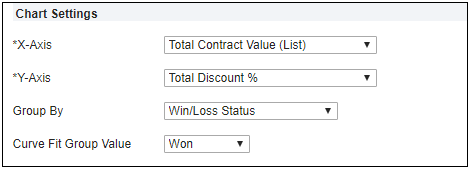
- X-Axis - select which attribute will be represented on the x-axis. This selection will also be the x-axis name on the chart.
- Y-Axis - select which attribute will be represented on the y-axis. This selection will also be the y-axis name on the chart.
- Group By (optional) - select how data items are grouped.
- Curve Fit Group Value (optional) - select the curve fit value if "Group By" is used.
-
Define Filters.

- Date Filter - The name of the Commerce date attribute used to filter historical Transactions for the analysis. System attributes such as 'System Last Modified Date' may also be selected.
- Duration - The time period prior to today's date to include in the analysis. The data selection duration is cumulative. Administrators may select from options including Last 30 days, Last 90 days, Last 6 months, Last 12 months, and All Transactions.
-
Advanced Filters allow administrators to limit the results displayed in Transaction and Transaction Line scatter plots.
Click Add Row to add additional items to filter. An unlimited number of filters for each Scatter Plot.
- Select Query Attributes from predefined Data Columns.
-
Select the Operator used to match the selected criteria.
Operators relevant to the query data type display to enable administrators easy and accurate editing of filters. Attributes without values can also be filtered out using the 'Is Empty' and 'Is Not Empty' operators, providing administrators with flexibility to assure that only clean data is included in their predictive model.
- If applicable, select Transaction Attributes or [Use Specified Value].
-
If applicable, select or define the Specified Value to be used in the query filter.
Select a value from a drop-down list for Menu or Boolean attributes, a date for Date attributes, or enter a value for Text or Numeric attributes.
For example, Scatter Plots can display only data for the same industry or customer present on the current Transaction.
-
Maximum Number of Records
The default value for Maximum Number of Records is "200", if a value is not specified a maximum of "1200" records will be used.
Enter the least number of Maximum Number Of Records acceptable for your business need. The maximum number of records is defaulted to 200, and cannot exceed 1,200. The more data points in a scatterplot, the larger its storage consumption. Each data point equals approximately 28 bytes of storage. A scatterplot with 200 data points takes approximately 5.6k bytes and 1,200 data points is 34k bytes of storage. The maximum limit for the scatterplot cache is 50M bytes. Once the storage limit is reached, the least recently used entries are removed from the cache to make space for new data point entries.
-
Select the Enable Cache checkbox.

-
Enter the number of minutes to retain the data point values in the cache before the values are refreshed from the database. The default is "1440" Minutes. The minimum value is "1" and maximum value is "7200" Minutes.
-
Select a value from the Truncate Advanced Filters Timestamp drop down to define the granularity (days or hours) of date-time attributes used to access cached data:
-
To Dates Only - Truncate Advanced Filters Timestamp attributes to date only and ignoring hours, minutes and seconds when data points are cached.
-
To Hours Only - Truncate Advanced Filters Timestamp attributes to include date and hour, ignoring minutes and seconds when data points are cached.
Before you enable cache, evaluate the caching effectiveness for the scatterplot. Caching is most effective if the scatterplot is shared among quotes and sales users. For example, a discount vs revenue scatterplot by sales regions is a good candidate for caching, as it is the same for all sales users in the same region. On the other hand, if every quote or sales user would see a different scatterplot (for example, quote history of the current sales user), caching is unlikely to be effective. Instead, in this example, you may want to set the HTML attribute to "Leave Value Unchanged" in its Modify tab. This prevents the HTML attribute from refreshing in the corresponding modify actions.
-
Select one of the following options:
-
Click Apply to save changes and remain on the Editor page
-
Click Update to save changes and return to the Analytics list page.
-
Click Update and New to define another analytic.
-
Click Back to return to the Analytics list page without saving changes.
 Preview Deal Comparison Analytic
Preview Deal Comparison Analytic
Administrators can now use a Preview function to view a Scatter Plot before displaying it in a Commerce Transaction. The ability for administrators to view deal comparisons can aid the analysis and definition of pricing rules and guidelines.
 Navigate to the Process Administration page.
Navigate to the Process Administration page.
- Click Admin to go to the Admin Home Page.
-
Click Process Definition in the Commerce and Documents section.
The Processes page opens.
-
Click the Process link in the Name column.
The Process Administration page opens.
- Select Analytics from the Navigation drop-down menu, then click List.
-
Select the applicable Deal Comparison analytic.
The Analytics Definition Editor page opens.
-
Click the Preview tab.
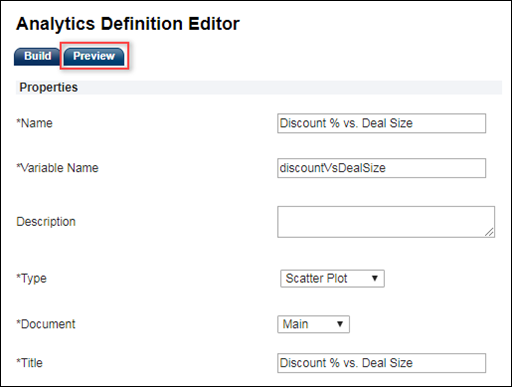
The Preview Scatter Plot page opens.
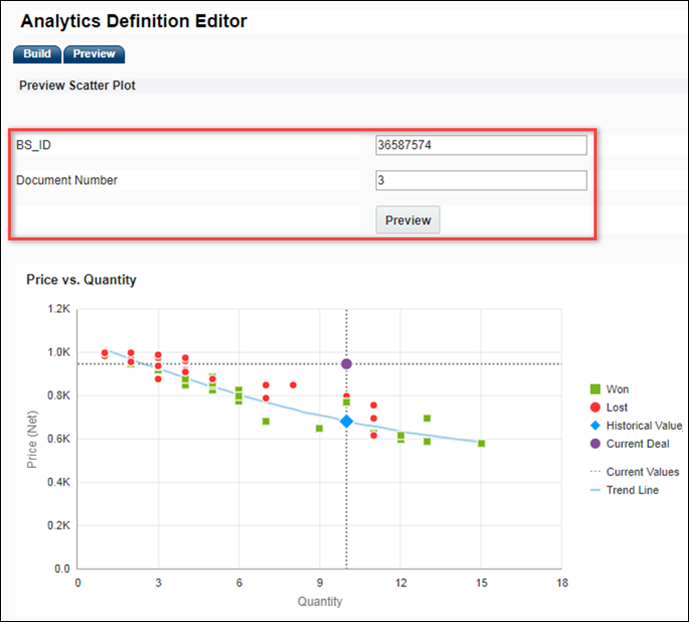
-
To preview a Transaction Scatter Plot:
- Enter a BS_ID (the identifier for an individual Commerce Transaction) for a Transaction.
- Click Preview.
-
To preview a Line-level Scatter Plot:
- Enter a BS_ID.
- Enter a Document Number integer value for the line to be displayed.
- Click Preview.
 Display Related Transactions from a Deal Comparison Scatter Plot
Display Related Transactions from a Deal Comparison Scatter Plot
Beginning in Oracle 20B, JET UI users can access related Transaction and Transaction Line details from a Deal Comparison Scatter Plot.
Complete the following steps to open related Transaction details:
- Open the Deal Management Analytics section of the Transaction or Transaction Line to display a scatter plot.
- (Optional) Hover over data points within the scatter plot to view data point summary information.

- Click on a data point to open a new tab containing either the Transaction or Transaction Line details specific to that data point.
End users can only access the Transaction and Transaction Line details they have permission to view.
 Copy Analytics
Copy Analytics
Administrators can copy Scatter Plot, Win Probability, Price Optimization, or Price Guidance analytics. This functionality allows administrators to quickly define and preview alternative analytics to evaluate the results with differing inputs.
Complete the following steps to copy an analytic:
- Navigate to the Admin Home page.
-
Under Commerce and Documents, click Process.
The Processes page opens.
- Select Analytics from the Navigation menu, next to the applicable process.
-
Click List.
The Analytics List page opens.
-
Select the checkbox next to the applicable analytic.

-
Click Copy.
The Analytics Definition Editor page opens.
- Update the analytic properties as desired.
- Initiate machine learning to train the new analytic.
- Preview the new analytic to analyze the results.
Note: Training sessions and results, and analytic output actions and attributes are not copied as part of the cloning process.
 Migrate Deal Management Analytics
Migrate Deal Management Analytics
The Migration Center is the user interface where all migration takes place within Oracle CPQ. Deal Management Analytics are displayed in the Analytics folder under the applicable Commerce process. Deal Management Analytics are migrated when the parent Commerce process is migrated.
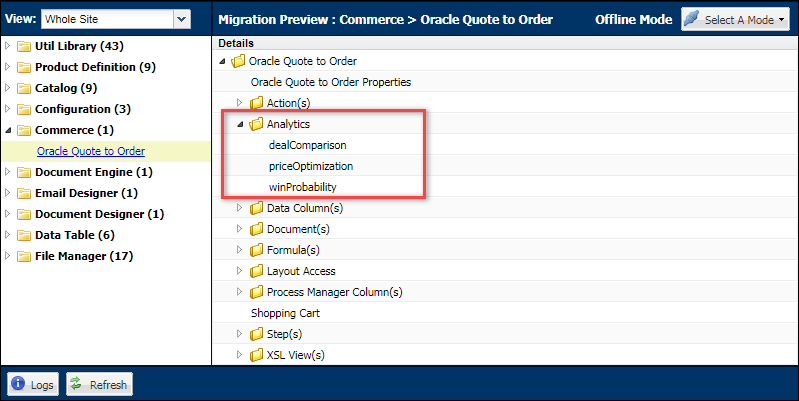
Notes
Notes:
- Win Probability, Price Optimization, Price Guidance Gauge, and Scatter Plot HTML attribute data is not printed in Document Designer and Email Designer outputs.
- Commerce attributes used in the analytic must exist as Data Columns.
Custom Variable Name Conventions
In Oracle CPQ 23D, CPQ adopted Oracle CX Sales variable naming conventions for custom items. When an administrator creates a new custom Commerce item, the "_c" suffix is appended to the variable name. The new naming convention for custom variable names provides more consistency for integrations with Oracle Sales.
Beginning in Oracle CPQ 24C, customers can submit a service request to disable the "_c" suffix on variable names for custom Commerce entities (Actions, Analytics, Attributes, Data Columns, Integrations, Library Functions, Rules, Steps, etc.). The "_c" suffix is enabled by default for standard and legacy Commerce processes.
- Customers can submit a Service Request (SR) on My Oracle Support to disable the "_c" suffix on variable names for custom Commerce entities
- When the "_c" is disabled, the "_c" variable name suffix will not be required for newly created custom Commerce entities.
- Disabling the "_c" variable name suffix for custom Commerce entities will not change existing variable names.
- The "_c" suffix setting will not impact existing variable names when cloning a Commerce process or migrating Commerce items. Target variable names will be the same as the variable names from the source Commerce process.
Related Topics
 See Also
See Also

![]() Average Historical Value Hover
Average Historical Value Hover
![]() Create a Scatter Plot Analytic
Create a Scatter Plot Analytic
![]() Preview Deal Comparison Analytic
Preview Deal Comparison Analytic
![]() Display Related Transactions from a Deal Comparison Scatter Plot
Display Related Transactions from a Deal Comparison Scatter Plot
![]() Migrate Deal Management Analytics
Migrate Deal Management Analytics



















